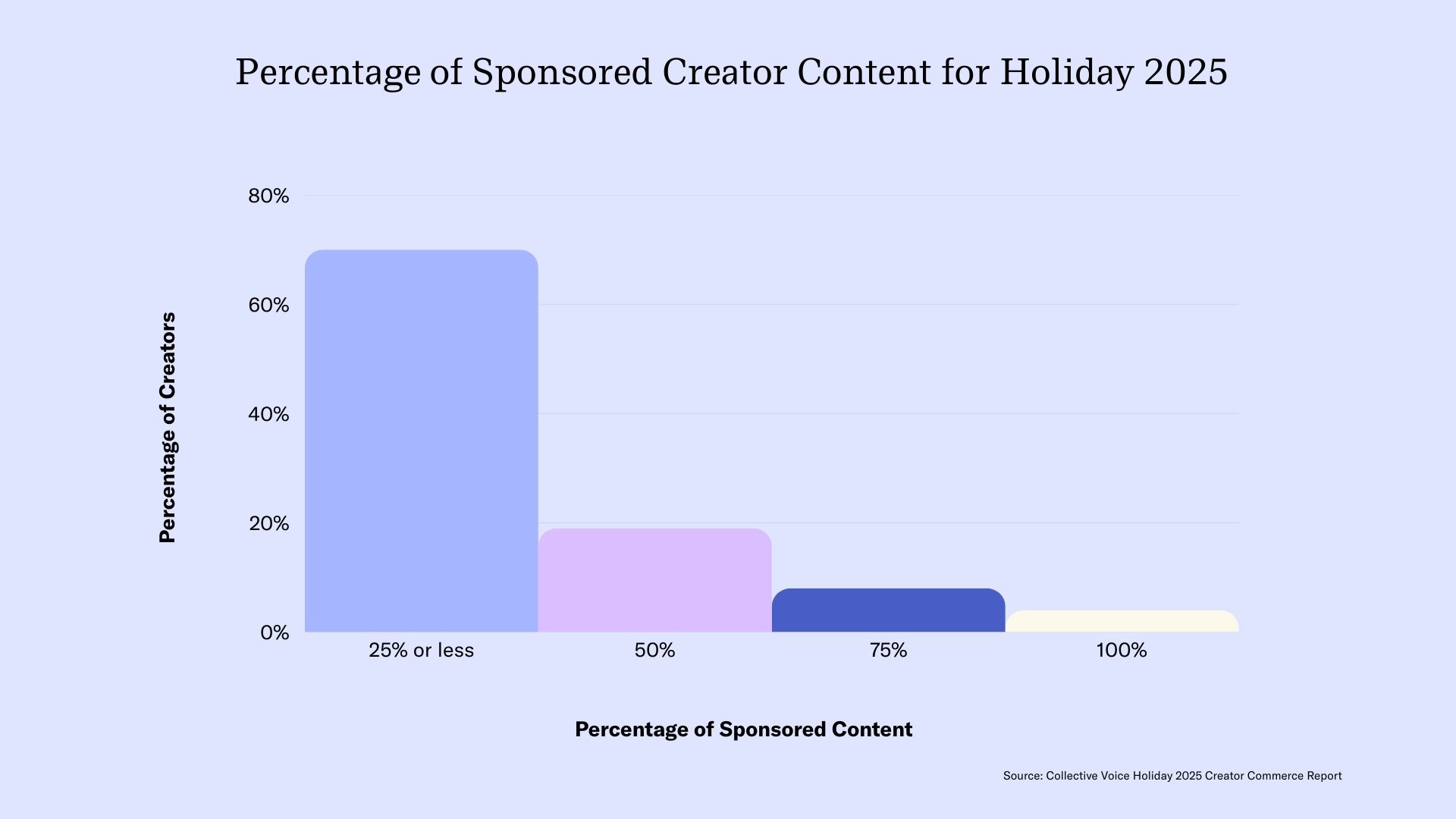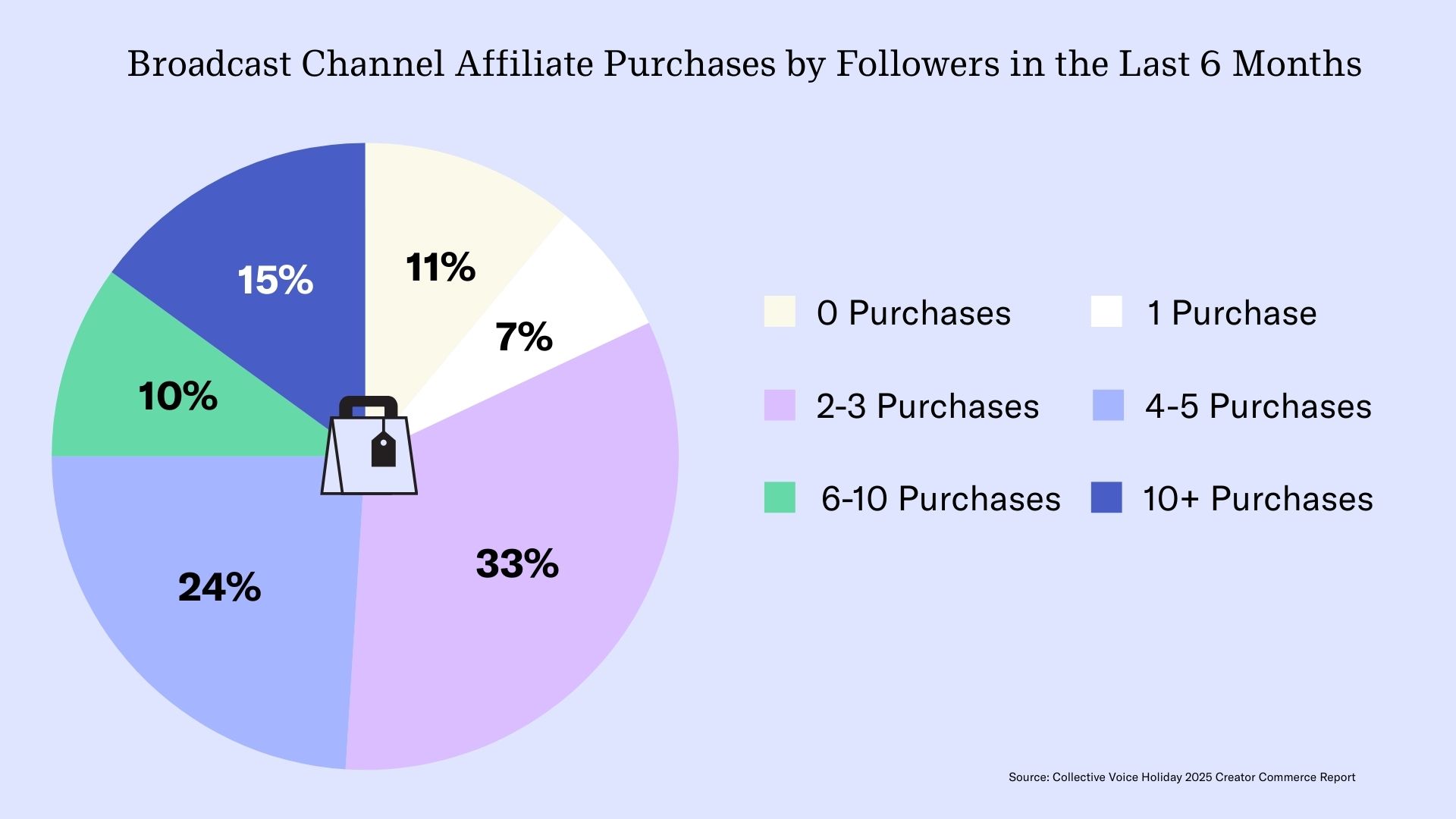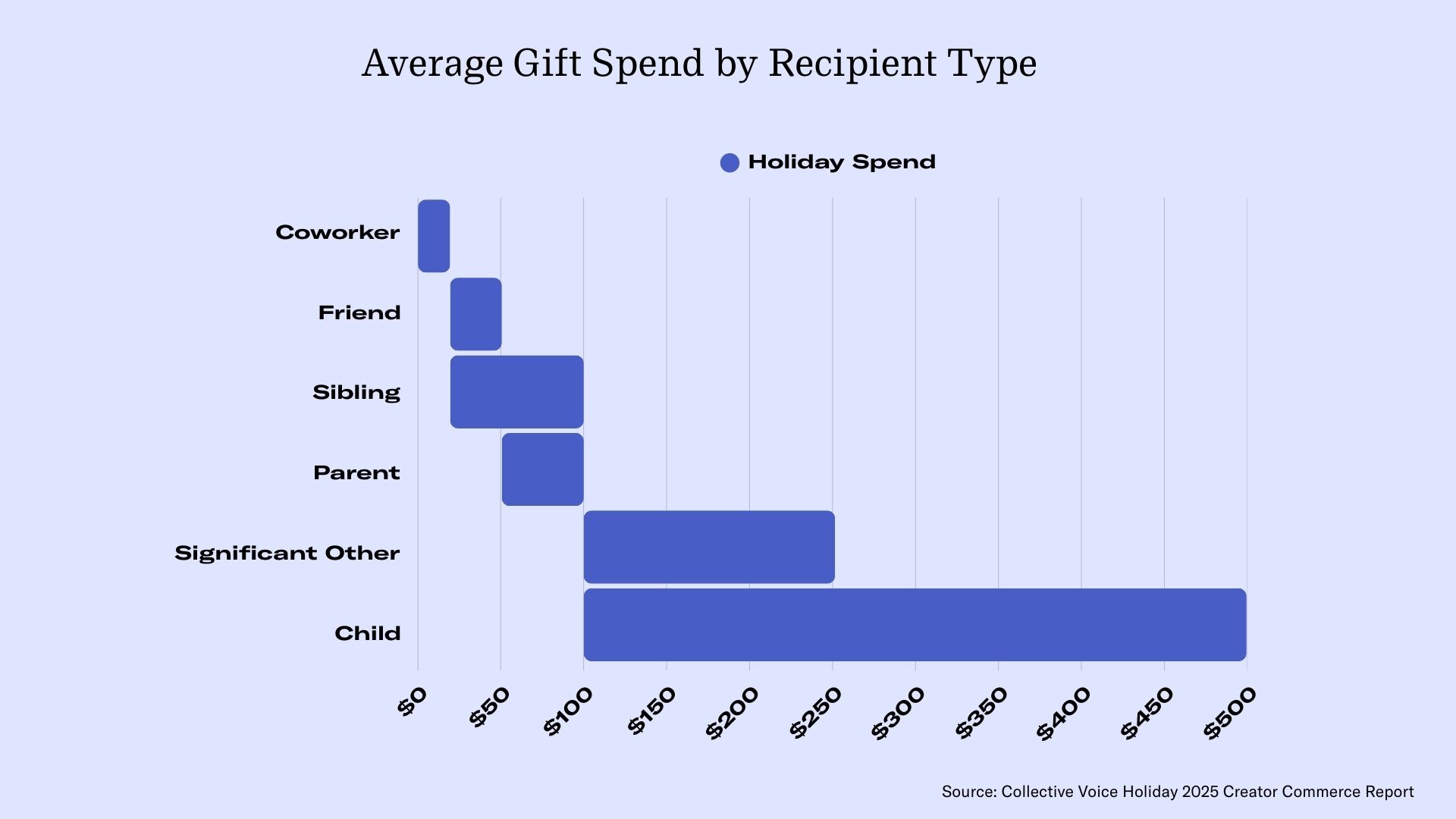Holiday 2025 Creator Commerce Report

As the 2025 holiday season approaches, creators aren’t just planning more content, they’re rethinking the strategy behind it and making bold moves that boost their earning potential and reshape how commerce happens online.
New research from Collective Voice, surveying both our creator community and US consumers, reveals a major shift underway in how creators are approaching Q4 earnings. Creators are moving away from flat-fee sponsorships in favor of performance-based affiliate content, and shoppers are rewarding authenticity, utility, and community-driven recommendations in new formats.
This dual lens, creator behavior and consumer expectations, shows exactly how content and commerce are converging this holiday season.
As Brand Deals Shift, Affiliate is a Financial Priority
This holiday season, creators are signaling a clear shift. While sponsored content remains part of the mix, it’s no longer the centerpiece. 70% of creators say traditional sponsored posts will make up just a quarter or less of their holiday content. Instead, they’re leaning into affiliate strategies, favoring organic, performance-driven posts that feel more native to their audiences.

This evolution reflects a broader desire for flexibility, autonomy, and scalable income and it signals that affiliate marketing is no longer an emerging opportunity, but a foundational revenue stream. According to our 2025 Monetization Trends Among Next-Gen Creators Report, 83% of creators are already familiar with affiliate marketing, and nearly half have been active on affiliate platforms for over a year. This monetization channel is becoming widely adopted because it allows creators to earn based on performance while maintaining full creative control. As one surveyed creator put it: “Flat fees are nice, but I can make more with good commissions and gifting.”
When asked what they value most from brand partners, creators ranked early product access and gifting highest, followed closely by high commissions. While flat-fee compensation ranked lower for holiday-specific content, it remains a key tool in a well-rounded creator partnership strategy.
Broadcast Channels: A Quiet Giant in Social Commerce
Instagram Broadcast Channels quietly emerged as one of 2025’s most efficient and effective affiliate formats. These opt-in chat threads are gaining serious traction with both creators and consumers, and the numbers speak for themselves. 75% of consumers surveyed were familiar with the feature, and among them, over half check broadcast channels daily, with nearly one-third engaging at least once a week. More importantly, 89% of active followers have made a purchase through a Broadcast Channel in the past six months, with 49% having made 4 or more purchases.
“Instagram Broadcast Channels have been a game changer for me. They’ve unlocked a more direct and meaningful way to connect with my community, especially the intentional shoppers who drive the bulk of my affiliate performance. Beyond engagement, it’s led to real business impact, with noticeable lifts in both affiliate sales and brand revenue. It’s not just a channel, it’s a strategic tool for creators.” says content creator, Chanel Tyler.

This kind of engagement is rare and highly valuable. Top-performing content in these channels includes beauty (32%), fashion (21%), and deal alerts (16%), all categories where timeliness and trust matter. And it’s Gen Z and Millennials who are leading this trend, making this format especially ripe for brands aiming to reach younger, high-intent audiences.
“We’re anticipating a shift from passive viewing to participatory social commerce. As this evolution continues, Broadcast Channels won’t just support creator strategies, they’ll become critical sales engines. Creators who integrate them as full-funnel commerce tools, rather than just messaging platforms, will be best positioned to drive meaningful results. ” – Catherine Halaby, VP, Creator Relations at Collective Voice.
Comments are the New Review Section
In 2025, the comment section is more than chatter, it’s a modern-day review forum. 62% of shoppers say they check the comment section before making a purchase, using the conversation around a product to validate their choices and get community buy-in. This peer-to-peer dialogue deepens trust and helps move consumers from consideration to conversion.
That trust doesn’t come from polish, it comes from transparency. 65% of consumers say they trust influencers more when they share both the pros and cons of a product, appreciating when creators are candid about what didn’t work for them.
Interestingly, expert reviews and traditional endorsements now rank lowest in trustworthiness, a signal that consumers view creators as the true authorities. Shoppers are prioritizing firsthand experiences, real-life product demos, and creators’ authentic stories like personal narratives that reflect genuine use, honest opinions, and a connection to their own lifestyles, over traditional advertising. over traditional advertising.
And creator posts continue to influence purchasing decisions well beyond the moment they’re published. While 41% of consumers say they click to shop directly from a creator’s content, 31% save posts or wishlist products for later. 68% frequently revisit past posts when shopping, and 17% always go back to reference them before purchasing.
“This report makes it clear that the future of holiday shopping isn’t just search, it’s scroll. And creators are the new personal shoppers.” — Catherine Halaby, VP, Creator Relations at Collective Voice
Holiday Shopping Is a Season, Not a Moment
Holiday shopping spans several months, with clear surges in consumer activity. While 14% of shoppers begin as early as September and 20% in October, the bulk of shopping happens in November (26%), continuing strongly through December (44%). Even in the final week before the holidays, 22% of consumers are still making purchases. This earlier start represents a departure from last year, where our 2024 holiday report showed consumers initiating their shopping in October. For brands, this evolving consumer behavior necessitates a strategic shift from isolated campaigns to sustained, multi-phased approaches that align with these varied timelines.
Different generations approach holiday shopping differently. Gen Z tends to shop late and in concentrated bursts right up until the week of the holiday. Millennials prefer to start in November and wrap up in December, while Gen X and Boomers shop gradually, beginning as early as September and maintaining a steady rhythm.
Gifting budgets follow a clear hierarchy based on relationship to the consumer and creators and brands should plan accordingly. Consumers spend the most on their children, with most budgeting between $101–$500. Significant others come next, typically falling in the $101–$250 range. Gifts for parents tend to land between $51–$100, while siblings receive $21–$100 gifts. Friends are usually budgeted at $21–$50, and coworkers at under $20. This structured approach to spending should inform how brands and creators build their gift guides and organize by both price tier and relationship type to better reflect real-world shopping behavior.

“Content is the new shelf space and this holiday season, that shelf lives on social media, not in-store and online. Just like traditional retail, consumers expect to browse by price and by who they’re shopping for. Creators and brands should mirror that mindset by segmenting holiday content by price tier and relationship type.” – Clair Sidman, VP, Marketing at Collective Voice
This is especially true when it comes to high-consideration purchases. In fact, 61% of consumers say a trusted creator’s recommendation makes them more likely to splurge on big-ticket or luxury items proving that authentic influence drives not just awareness, but meaningful action at the highest tiers of spend.
Automation Tools Will be the Real MVPs This Holiday
As holiday shopping stretches across months, creators are feeling the pressure to consistently deliver timely, relevant content and keeping up with that demand is not easy. One in three creators are already posting more than four times a day across platforms, and 70% expect their output to increase even more during the holiday season. To stay on pace, many are linking to products multiple times per day and relying on gift guides, curated lists, and deal roundups to drive conversions.
“I’d post more… but I’m maxed out,” one creator shared, a sentiment echoed by many. This reality underscores the importance of easy-to-use monetization infrastructure. Tools that automate affiliate linking, simplify cross-platform content creation, and streamline analytics aren’t just nice-to-haves, they’re essential for sustaining volume without burnout.
“These findings reinforce the need for monetization tools to meet creators where they are, on the go, in their DMs, and crossposting across multiple platforms. That’s why our tools are built for speed and scale without friction. Our Shop The Look tool combines AI and DM automation to make sure creators affiliate links are working hard for them, even when they are offline.” – Clair Sidman, VP, Marketing at Collective Voice.
Performance data is also playing a larger role in content planning. Creators are polling their audiences, monitoring real-time engagement, and doubling down on what converts. This data-savvy approach, paired with smart monetization tools, allows creators to work more efficiently and strategically during their busiest season.
Live Shopping: High Consumer Interest, Low Creator Adoption
While live shopping streams continues to intrigue brands and consumers alike, creators are largely sitting it out. However, there’s a disconnect: 20% of creators say they anticipate brands will be requesting live-stream deliverables for holiday campaigns, yet 90% have never hosted a live stream and most don’t plan to.
Creators cite five main barriers: lack of knowledge, on-camera discomfort, time and energy demands, technical issues, and misalignment with their personal brand or audience expectations. Live shopping often requires significant effort for uncertain return, making it a hard sell for creators already at capacity.
That said, consumer appetite for live shopping is real. Nearly half have joined a live stream in the past six months, and 80% say they’re likely to make a purchase while watching (45% “very likely” and 35% “somewhat likely”). There’s untapped potential here, but unlocking it will require brand partners to provide hands-on support, simplify the experience, and make the upside worth the lift if they really want creators to adopt this format for their campaigns this holiday season.
Strategic Takeaways for Holiday 2025
This year’s insights reveal that the most impactful brand strategies are rooted in trust, transparency, and shared goals. To put these insights into action, focus on the following key strategies:
Lead with affiliate and gifting, AND flat fees.
Today’s creators are prioritizing monetization models that reward performance and preserve creative freedom. Flat fees alone are no longer the incentive they once were. Instead, early product access and gifting combined with competitive commissions drives stronger engagement and ROI for both creators and brands.
Make affiliate tools seamless and scalable.
Creators need intuitive systems for linking and performance tracking. Giving them automation, insights, and mobile-first tools increases efficiency and reduces friction, key factors during busy Holiday moments.
Comments are the conversion lever.
Consumers respond to transparency. Content that honestly showcases both the strengths and limitations of a product not only converts better but also builds deeper brand loyalty. Get involved in the conversations creators and audiences are having about your products.
Broadcast Channels are powering quiet conversions.
Especially among younger audiences, Broadcast Channels are emerging as high-intent environments. Give creators exclusive content and product sneak peeks that reward loyalty and drive repeat purchasing.
Match your content to the new holiday rhythm.
With consumers shopping in distinct waves, from early planners to last-minute gifters, your strategy should evolve alongside them. Align campaigns with these behavioral phases, and use tiered pricing and messaging to speak to every segment.
Live shopping needs more than a link.
Interest in live shopping is growing, but creators can’t go it alone. For this format to work, brands must invest in co-creation, not just deliver a creative brief and hope for the best.
This holiday season will favor brands that treat creators not as media placements, but as growth partners. The data is clear: when creators are empowered with the right tools, rewarded for real results, and trusted to speak in their own voice, performance follows. The most successful campaigns this season won’t just entertain or inform, they’ll convert, because they’re built on alignment, authenticity, and shared business outcomes. The future of commerce is co-created and the time to invest in that future is now.

